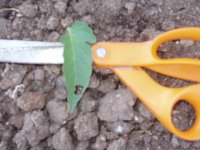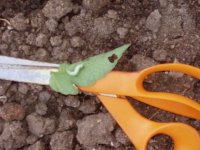nickel plate
Veteran Member
After years of trying to eradicate tomato horn worms from from my vegetable garden I think I have finally hit on a mechanical, non-chemical method of keeping them in check.
I've tried everthing that has ever been suggested to me including hunting them in the moonlight with a flashlight, (not a good idea as it almost sounds like a snipe hunt) searching out the eggs (too much leaf twisting and poor results) to various toxic and non-toxic solutions.
My weapon of choice is a pair of 10" scissors, 12" may be better for reaching into the plant but 10" works just fine.
Hunting time is early in the morning or at dusk (I prefer the A.M.) when the sun is not on the plants or anytime they are in shade. These conditions make seeing the targets alot easier.
The targets are leaves with hole(s) in them, very easy to see. Hold onto the leaf and use the scissors and cut off the leaf leaving the rest of the stem intact. Turn the leaf over and you will 99% of the time see a newly hatched small tomato horn worm. Again use the scissors to cut the leaf AND the tomato horn worm all in one slice! Discard it and move on. This method of single leaf removal also helps to easily locate future fresh targets without having to look at the same holed leaf more than once. HINT: Concentrate more on the middle aged leaves and not the real young ones as the worms need a length of time to hatch out and punch that first hole. I have ten plants and when I began this method of hunting a few weeks ago, I would get a couple of dozen leaf worms a morning along with many four inch "lunkers". I think that now I have broken the growth cycle as I am down to about a half dozen leaf worms a morning and practially no lunkers however the eggs are still being laid.
Search for the eggs while hunting the holed leaves. They look like a white pearl about the size of a pin head, maybe just a bit larger. They are layed individually and glued to the top or bottom of the leaf so cut the leaf off and pinch the egg between your fingernails and it will pop. Use any other method of extermination if that makes you squeamish.:laughing:
Finding and killing the 1/4" long juvenile (I photographed a larger worm so the camera would pick it up better) is more effective than searching out the 4" highly camouflaged adult worm in that you are saving the destruction of quite a bit of still producing tomato foliage.
Good luck and good hunting.
I've tried everthing that has ever been suggested to me including hunting them in the moonlight with a flashlight, (not a good idea as it almost sounds like a snipe hunt) searching out the eggs (too much leaf twisting and poor results) to various toxic and non-toxic solutions.
My weapon of choice is a pair of 10" scissors, 12" may be better for reaching into the plant but 10" works just fine.
Hunting time is early in the morning or at dusk (I prefer the A.M.) when the sun is not on the plants or anytime they are in shade. These conditions make seeing the targets alot easier.
The targets are leaves with hole(s) in them, very easy to see. Hold onto the leaf and use the scissors and cut off the leaf leaving the rest of the stem intact. Turn the leaf over and you will 99% of the time see a newly hatched small tomato horn worm. Again use the scissors to cut the leaf AND the tomato horn worm all in one slice! Discard it and move on. This method of single leaf removal also helps to easily locate future fresh targets without having to look at the same holed leaf more than once. HINT: Concentrate more on the middle aged leaves and not the real young ones as the worms need a length of time to hatch out and punch that first hole. I have ten plants and when I began this method of hunting a few weeks ago, I would get a couple of dozen leaf worms a morning along with many four inch "lunkers". I think that now I have broken the growth cycle as I am down to about a half dozen leaf worms a morning and practially no lunkers however the eggs are still being laid.
Search for the eggs while hunting the holed leaves. They look like a white pearl about the size of a pin head, maybe just a bit larger. They are layed individually and glued to the top or bottom of the leaf so cut the leaf off and pinch the egg between your fingernails and it will pop. Use any other method of extermination if that makes you squeamish.:laughing:
Finding and killing the 1/4" long juvenile (I photographed a larger worm so the camera would pick it up better) is more effective than searching out the 4" highly camouflaged adult worm in that you are saving the destruction of quite a bit of still producing tomato foliage.
Good luck and good hunting.


